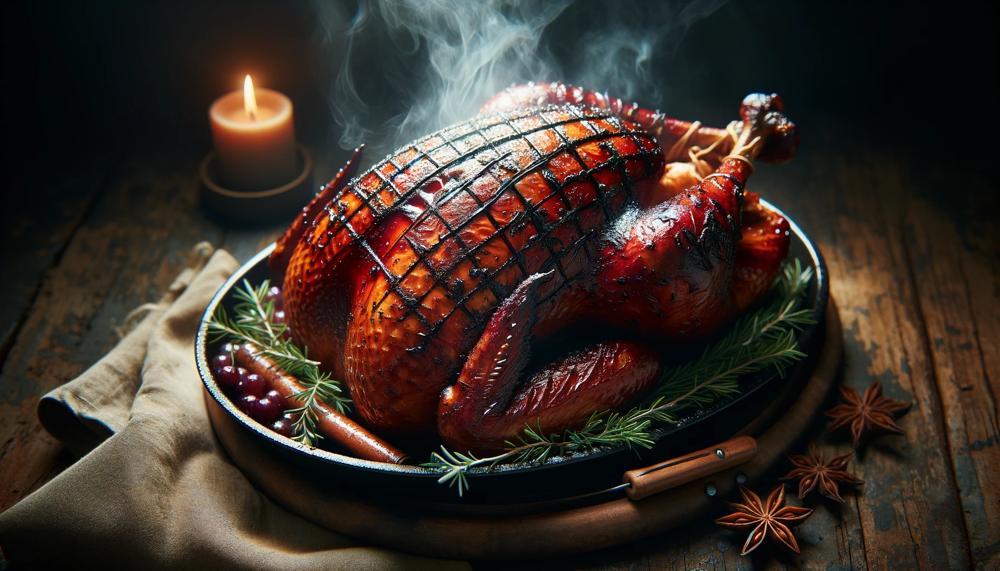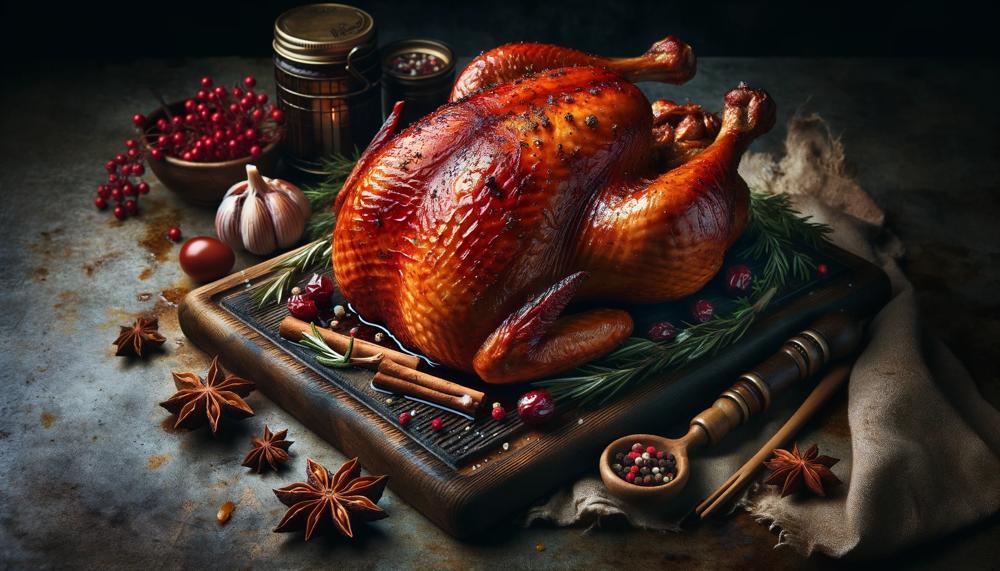As the holiday season approaches, it’s time to start planning for the ultimate Thanksgiving feast. While a traditional roasted turkey may be the go-to centerpiece, have you ever considered smoking your turkey in advance and reheating it on the big day? This unconventional method not only saves time and oven space, but also adds a mouthwatering smoky flavor to your bird.
So, let’s explore the question on everyone’s mind: is it possible to smoke a turkey ahead of time and reheat it?
Yes, you can smoke a turkey ahead of time and reheat it. Some say you can smoke a turkey up to two days before Thanksgiving and then reheat it in the oven on Thanksgiving day. According to the USDA, you should refrigerate meat and poultry within two hours of removing it from a smoker. You can reheat turkey in the oven at a temperature no lower than 325°F.
Ready to elevate your Thanksgiving game?
Keep reading for our top tips on how to smoke your turkey in advance and reheat it like a pro.
Contents
- 1 Key Takeaways
- 2 Can it be reheated?
- 3 Tips for smoking
- 3.1 Consider Smoking Two Smaller Turkeys Instead of One Large Bird
- 3.2 Thoroughly Thaw the Turkey Before Smoking
- 3.3 Brine the Turkey Ahead of Time
- 3.4 Maintain a Low Temperature While Smoking
- 3.5 Use a Meat Thermometer to Monitor Internal Temperature
- 3.6 Allow the Turkey to Rest After Cooking
- 3.7 Store the Turkey Properly for Reheating
- 3.8 Reheat Using Low and Slow Methods
- 4 Choose smaller turkeys
- 5 Fully defrosting the turkey
- 6 Butterfly the turkey
- 7 Brine the turkey
- 8 Use a low temperature
- 9 Track the internal temperature
- 9.1 Insert the thermometer into the thickest part of the turkey.
- 9.2 Ensure the thermometer is not touching any bones or fat.
- 9.3 Follow recommended cooking temperatures.
- 9.4 Allow the turkey to rest before carving.
- 9.5 Use a low temperature and baste frequently when smoking.
- 9.6 Choose high-quality wood and marinate or brine beforehand.
- 10 Conclusion
Key Takeaways
Smoking a turkey ahead of time and reheating it can be a real lifesaver during busy holiday seasons.
However, there are some drawbacks to keep in mind. Proper storage and reheating techniques are essential to retain the delicious flavor and avoid any potential foodborne illnesses.
It is highly recommended to defrost the turkey before smoking it, and closely monitor its internal temperature to ensure it is fully cooked. In addition, brining and butterflying the turkey can greatly enhance its taste and tenderness.
While fresh-from-the-smoker turkey is always preferred, there may be situations where reheating in advance is necessary.
Can it be reheated?
The answer is yes, and here’s how to do it properly for the best results.
| Step | Action |
| 1 | Store correctly in fridge |
| 2 | Reheat in oven at 325°F |
| 3 | Baste with butter and oil every 30 minutes |
| 4 | Check internal temperature with meat thermometer (165°F) |
| 5 | Rest for 15 minutes before serving |
| 6 | Add broth or stock for extra moisture and flavor (optional) |
Other tips for reheating smoked turkey include using a smoker with wifi notifications to track the cooking process, defrosting the turkey beforehand, and following the smoker’s recommended cooking time. It’s also important to give yourself enough time on the day of the event to properly reheat the turkey.
Tips for smoking
Preparing a smoked turkey in advance and reheating it can be a time-saving trick for busy cooks, but it requires careful preparation and attention to detail to achieve the best flavor and texture. Here are some tips to help you achieve a delicious smoked turkey that can be reheated without sacrificing its flavor and moisture.
Consider Smoking Two Smaller Turkeys Instead of One Large Bird
Opting to smoke two smaller turkeys instead of one large bird not only saves time but also prevents it from drying out.
This also allows for more even cooking and better distribution of flavor.
Thoroughly Thaw the Turkey Before Smoking
To ensure food safety and even cooking, it is crucial to fully defrost the turkey before smoking.
You can do this by placing the turkey in the refrigerator for 24 hours for every five pounds of turkey. If you’re short on time, you can use the cold water method by submerging the turkey in cold water for 30 minutes per pound.
Brine the Turkey Ahead of Time
Brining the turkey beforehand can enhance its moisture and flavor during smoking.
You can use a simple brine solution of water, salt, sugar, and spices or experiment with different flavors like apple cider or bourbon.
Maintain a Low Temperature While Smoking
Maintaining a low temperature of no more than 225 degrees Fahrenheit while smoking allows for better flavor and moisture retention.
You can add smoky flavor by using wood chips or pellets while keeping the temperature low.
Use a Meat Thermometer to Monitor Internal Temperature
Using a meat thermometer to track the internal temperature of the turkey is crucial for achieving perfect doneness. The white meat should reach 165 degrees Fahrenheit, while the dark meat should reach 175 degrees Fahrenheit.
Allow the Turkey to Rest After Cooking
Allowing the turkey to rest for at least 20-30 minutes after cooking helps improve tenderness and flavor. This also allows the juices to redistribute, preventing a dry turkey.
Store the Turkey Properly for Reheating
To preserve the flavor of the turkey when reheating, it is important to store it properly in an airtight container or tightly wrapped in foil. This will also prevent contamination and keep the turkey moist.
Reheat Using Low and Slow Methods
When reheating the smoked turkey, it is best to use low and slow methods to prevent it from drying out. You can use an oven set at 300 degrees Fahrenheit or a skillet with broth or gravy to reheat the turkey.
Choose smaller turkeys

When it comes to smoking and reheating turkey, selecting a smaller turkey can significantly alter the overall process. Here’s why:
- Quicker and more uniform cooking: Smaller turkeys cook at a faster rate and with more consistency than larger ones. This is due to their lower meat content, which means they reach the desired internal temperature much faster. This is especially important when smoking a turkey, as uneven cooking can result in dry or undercooked meat.
- Easier to handle and store: Smaller turkeys are also easier to handle and store compared to larger ones. They take up less space in the fridge or freezer, making it more convenient to save leftovers. They are also easier to manipulate on the grill or smoker, which can be a challenging task with larger birds.
- Less time needed for reheating: When reheating leftover turkey, smaller turkeys require less time in the oven or on the stovetop compared to larger ones. This is because there is less meat that needs to be reheated, resulting in faster and more efficient reheating.
- More flavorful: Smaller turkeys tend to be more flavorful compared to larger ones. This is because they have a higher ratio of skin to meat, which adds more flavor during the cooking and smoking process. Additionally, smaller turkeys can be effectively brined, resulting in a juicier and more flavorful end result.
- Easier to monitor internal temperature: Monitoring the internal temperature of a turkey is crucial for both smoking and reheating. Smaller turkeys are easier to monitor as they reach the desired temperature quicker, reducing the risk of overcooking or undercooking.
To demonstrate the difference between smaller turkeys and larger ones, here is a comparison table:
| Dimensions | Cooking Time | Internal Temperature |
| Small turkey (12-14lbs) | 2-3 hours | 165°F |
| Large turkey (18-20lbs) | 4-5 hours | 165°F |
Based on this table, it is evident that smaller turkeys require a shorter cooking time and reach the desired internal temperature faster, making them a more efficient option for smoking and reheating.
Fully defrosting the turkey
When it comes to preparing a turkey for smoking, the recommended approach is to fully defrost it beforehand. This can be done in a safe and gradual manner using either the refrigerator method or the cold water method.
Defrosting a turkey properly is crucial because it prevents harmful bacteria from growing on the meat, ensuring that it is safe to eat. But how do you defrost a turkey safely without compromising its taste and texture? Let’s explore the two methods in more detail.
The first method involves using the refrigerator. This method is ideal if you have enough time before you plan on smoking the turkey. Simply place the frozen turkey on a tray and put it in the fridge. Allow 24 hours of defrosting time for every 4-5 pounds of turkey. This means that a 20-pound turkey would take around four to five days to fully defrost in the fridge.
If you don’t have that much time, you can opt for the cold water method. This method requires you to submerge the wrapped turkey in cold water, changing the water every 30 minutes until the turkey is completely thawed. This process usually takes about 30 minutes per pound of turkey, so a 20-pound turkey would take around 10 hours to defrost using this method.
Whichever method you choose, make sure to follow proper food safety guidelines and never defrost a turkey at room temperature as it can lead to bacterial growth.
Butterfly the turkey
To achieve the perfect smoked and reheated turkey, the best approach is to butterfly it by delicately removing the backbone and flattening the bird before adding seasoning and cooking.
By doing this, you ensure an evenly cooked and well-smoked turkey, making carving and serving a breeze.
Brine the turkey
The main purpose of brining a turkey before smoking it is to elevate the taste and texture of the meat.
This is achieved by tenderizing the meat and adding moisture to it. The addition of salt in the brine solution aids in breaking down the tough muscle fibers in the meat, increasing its ability to absorb moisture and retain its natural juices.
As a result, the smoked turkey becomes more juicy and tender, rather than dry and chewy. Moreover, brining also imparts a depth of flavor to the turkey as the salt and other seasonings penetrate deep into the meat.
This leads to a more intricate and delicious final product. Apart from enhancing flavor, brining also plays a crucial role in the texture of a smoked turkey.
By forming a protective layer on the surface of the meat, it ensures even and consistent cooking, resulting in a perfectly cooked turkey every time.
Use a low temperature
Smoking and reheating a turkey requires special care, especially when it comes to temperature. A low temperature is essential for both smoking and reheating as it helps maintain moisture in the meat and prevents it from becoming dry.
Smoking Turkey at a Low Temperature:
Smoking a turkey at a low temperature, between 225-250 degrees F, is the key to achieving an evenly cooked and juicy bird. This gentle cooking process allows the meat to retain its natural juices, resulting in a succulent and flavorful turkey.
Additionally, the low temperature allows the smoke to slowly penetrate the meat, giving it a more intense and delicious taste.
Reheating Smoked Turkey at a Low Temperature:
When reheating smoked turkey, it is important to use a low temperature of around 250 degrees F. This ensures that the meat retains its moisture and doesn’t become dry and tough. Slow reheating also allows the flavors to develop and deepen, resulting in a more delicious final product.
Using a Probe Thermometer:
For best results when reheating smoked turkey, it is recommended to use a probe thermometer. This allows you to monitor the internal temperature of the meat, ensuring it reaches the safe temperature of 145-150 degrees F.
Resting Time:
After reheating, it is crucial to let the turkey rest for at least half an hour before carving and serving. This resting time allows the juices to redistribute evenly throughout the meat, making for a juicy and flavorful turkey.
Storing Leftover Smoked Turkey:
If you have leftover smoked turkey, it can be stored in the freezer for future use. To prevent it from drying out, it is important to disassemble the turkey before freezing.
When reheating leftover smoked turkey, add some fat and moisture like stock or butter to keep it from becoming dry.
To sum up, using a low temperature is crucial when smoking and reheating a turkey as it results in a tender and flavorful final product.
By following these tips and using a low temperature, you can enjoy a perfectly cooked and delicious smoked turkey every time.
Track the internal temperature
Achieving the perfect smoked turkey requires careful temperature monitoring and following recommended cooking temperatures.
Here are some helpful tips to assist you in tracking the internal temperature of your smoked turkey with ease.
Insert the thermometer into the thickest part of the turkey.
For accurate temperature tracking, it is crucial to insert the thermometer into the thickest part of the turkey, whether it be the breast, thigh, or wing.
Ensure the thermometer is not touching any bones or fat.
To obtain an accurate reading, make sure the thermometer is inserted only into the meat and not touching any bones or fat.
Wait for the thermometer to beep before removing it from the turkey.
Patience is key. Wait for the thermometer to beep before removing it from the turkey to ensure an accurate reading of the internal temperature.
Follow recommended cooking temperatures.
The recommended internal cooking temperature for a smoked turkey is 165 degrees Fahrenheit for the breast, 175 degrees Fahrenheit for the thigh, and 180 degrees Fahrenheit for the wing.
It is important to check different parts of the turkey to ensure it is fully cooked.
Allow the turkey to rest before carving.
After removing the turkey from heat, let it rest for at least 30 minutes before carving to allow juices to redistribute and enhance flavor.
Use a low temperature and baste frequently when smoking.
To achieve a succulent and flavorful smoked turkey, cook it at a low temperature (225 degrees Fahrenheit) for an extended period of time (3-4 hours per pound).
Basting frequently with melted butter or olive oil can also help keep the meat moist.
Choose high-quality wood and marinate or brine beforehand.
Enhance the smoky flavor of your turkey by using high-quality wood such as hickory, oak, or apple. Marinating or brining your turkey beforehand can also add flavor and moisture to the meat.
By utilizing these tips and a digital meat thermometer, you can easily track the internal temperature of your smoked turkey to ensure it is cooked properly and safe to reheat.
Conclusion
In conclusion, the answer is yes – you can definitely smoke a turkey ahead of time and reheat it for a stress-free and delicious holiday meal.
With proper storage and reheating techniques, your turkey will maintain its succulent texture and flavorful taste. Don’t forget to follow our expert tips for smoking and reheating to ensure the best results.
And for an even more efficient and flavorful experience, consider using smaller turkeys. So why stick to traditional roasted turkey when you can add a smoky twist to your Thanksgiving feast?
Impress your guests with your newfound skills in smoking and reheating like a pro.






